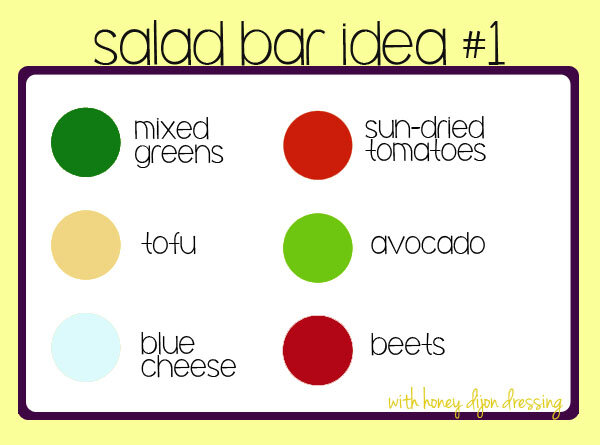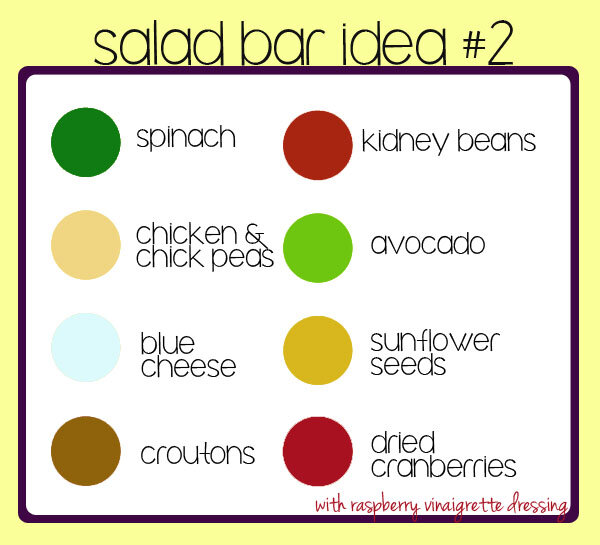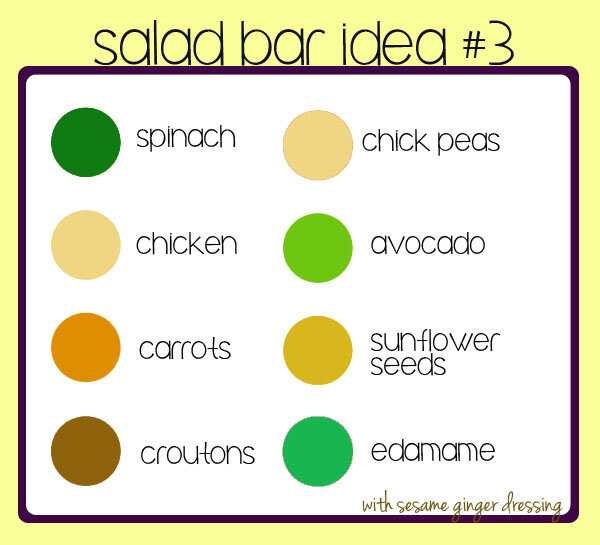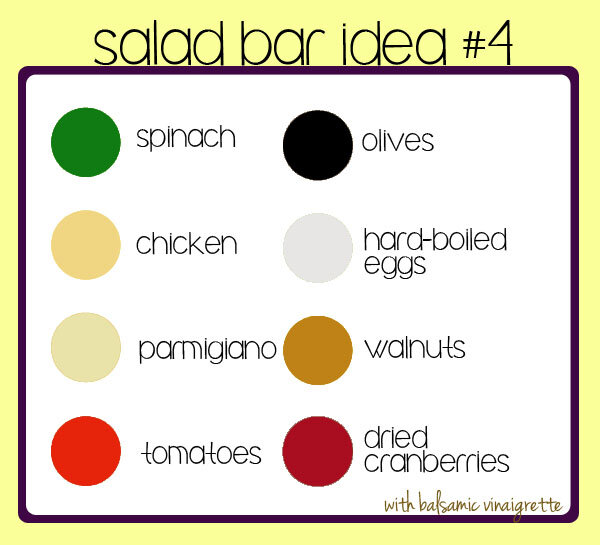How to Navigate the Salad Bar
Listen to Chrystina discuss how to navigate the salad bar in Season 1 Episode 2 of the Things I’m Working On podcast, above.
Last week I had the worst salad earlier this week for lunch. It had arugula, roasted Brussel sprouts, roasted mushrooms, red peppers, goat cheese, sunflower seeds, olive oil, salt, and pepper. Yes, all of these things sound great (that’s how they all ended up in a salad together), but there was no common theme to tie all of these ingredients together. (The too much olive oil part also didn’t help, it would have been better with a more cohesive dressing.)
The worst part of this is that four years ago I devoted a few months of my life to attempting to master the New York City salad bar. I did weeks of research, conducted interviews, and created sample salads in order to feel like I was able to navigate salad bars. I created a whole week’s worth of content to get all of my thoughts in one place back in 2013. However, I’m apparently still very far away from gaining my 10,000 hours to become a credentialed salad bar expert, because I still haven’t learned anything years later.
Just as a reminder to myself, and as a resource for you, in case you’re somebody who is new to salad bars or is paralyzed by opportunity when you approach the salad bar, I’m going to put all of my resources in one place to help you (and me) navigate salad bars. Here’s everything I’ve learned:
Tip 1: Understand the Parts of a Salad
There are a lot salads that already exist in the world. They’re pretty famous – and they’re famous for a reason – because they’re good. Let’s take a look at some pre-existing salads.
Chef’s Salad: Hard boiled eggs, ham, choice of meat, croutons, tomatoes, cucumbers, cheese, lettuce
Cobb Salad: Tomatoes, bacon, chicken, avocado, Roquefort cheese, chives, lettuce, vinaigrette
Caesar Salad: Parmesan cheese, lemon juice, olive oil, egg, black pepper, romaine lettuce
Waldorf Salad: Apple, celery, walnuts, grapes, mayonnaise, lettuce
Garden Salad: Tomatoes, carrots, onions, cucumbers, mushrooms, bell peppers, lettuce, croutons
Greek Salad: Tomatoes, cucumbers, green bell peppers, red onion, feta cheese, Kalamata olives, lettuce, olive oil
Oriental Salad: Mandarin oranges, sliced almonds, peanuts, fried Asian noodles, chicken, field greens, ginger dressing
Mexican salad: Lettuce, chicken, avocado, black beans, black olives, corn, tomatoes, tortilla chips, ranch dressing
In taking a look at each of these salads, there’s a few things that really make them work:
There’s a lot of color. If you have a salad that is all green things, you’re doing it wrong. Add something red, add something orange – the possibilities are endless.
There’s some crunch. If there’s no crunch in your salad, it’s essentially soggy vegetables. Whether your crunch comes from your lettuce choice, a topping (tortilla chips, sunflower seeds, croutons, etc), or bacon, adding that crunch will add more texture to your salad.
There’s some kind of protein. Whether you use eggs, chicken, ham, bacon, tofu, or beans, adding some kind of protein is going to be what keeps you full for a little bit after you’ve finished the salad.
I even made a printable that I actually printed and kept in my wallet for over a year.
Tip 2: Understand the Salad Bar
Here’s the part that always trips me up. Every salad bar looks different. Some have tofu, some don’t. Some have that ginger carrot dressing you love, some don’t. Some have buffalo chicken, some only have grilled chicken. My best advice is to get to know one place really well and develop a basic salad that you can quickly substitute your specialties out at other places. So let’s take a look at what you will typically (and atypically) find in a salad bar – sorted by category.
Greens: iceberg, romaine, mixed greens, spinach, kale, and more
Proteins: bacon, chicken, eggs, turkey, falafel, tofu, shrimp, steak, tuna, shrimp, salmon, beans, chick peas, and more
Cheese: feta, crumbled blue, goat, parmesean, mozzarella, cheddar, brie, and more
Vegetable-like foods: carrots, beets, roasted red peppers, sun-dried tomatoes, tomatoes, cucumbers, avocado, snow peas, artichoke, broccoli, edamame, sprouts, celery, olives, mushrooms, corn, and more
Fruit-like foods: apples, strawberries, oranges, grapes, mandarin oranges
Toppings: croutons, walnuts, crunchy noodles, tortilla strips, wontons, pumpkin seeds, sunflower seeds, peanuts, dried cranberries, and more
Dressings: oil, vinegar, lemon juice, peppercorn, ranch, Caesar, blue cheese, thousand island, carrot ginger, honey Dijon, Italian, sesame ginger, raspberry vinaigrette, and more
Once you have a better idea of what can possibly show up in front of you, you can figure out how to use the pieces to the best of your ability.
Tip 3: Ask Around for Suggestions
This is one that probably isn’t normal, but I started asking people what they put in their salads. Back in 2013, my co-workers thought I was weird. Now they’ve just accepted that this is how I function. I even created little graphics that I could search for and use while at the salad bar. (These are definitely my own personal most searched blog post through the years.) My go-to salad is Salad Bar Option #3.
The amount of times I’ve considered standing at the end of a salad bar and conducting a study just to understand how people put things together is incredible. All of that said, I would really love if you commented below with what your go-to salad is. I’m always looking for new suggestions. Three of my prior go-to salads were:
My Italian-Influence Choice: Arugala, pasta, roasted red peppers, cucumbers, black olives, broccoli, egg, chick peas, mozzarella, avocado, croutons, and italian dressing
My Mexican-Influence Choice: Iceberg lettuce, cheddar cheese, black beans, corn, chick peas, tomatoes, avocado, tortilla chips, and ranch dressing
My Asian-Influence Choice: Mixed greens, edamame, tofu, chick peas, snow peas, broccoli, sunflower seeds, avocado, and sesame ginger dressing
My go-to salads on my most recent job were:
My Can’t-Go-Wrong Salad: Spinach, broccoli, carrots, corn, garbanzos, cranberries, walnuts, blue cheese, avocado, breaded chicken, salt, pepper, and mango viniagrette
My Ranch-Inspired Salad: Spinach, broccoli, corn, garbanzos, black beans, cheddar cheese, black olives, avocado, breaded chicken, salt, pepper, and (chipotle) ranch dressing
My Goat-Cheese-and-Beet Salad: Spinach, broccoli, cucumbers, carrots, beets, cranberries, walnuts, tofu, goat cheese, salt, pepper, olive oil
My Asian-Inspired-But-They-Don’t-Have-All-The-Ingredients Salad: Spinach, broccoli, carrots, cucumbers, peas, almonds, tofu, salt, pepper, oriental dressing
Tip 4: Know Your Options
There are some salad options you might have that you weren’t considering before you started this process. I can’t guarantee that your salad bar will have these options, but they’re definitely worth looking into:
Salad dressing on the side
Bread on the side
Getting your salad chopped
These options are specific to certain delis and salad bars, but they’re worth asking about just in case you have more options than you really know.
8 Tips for Mastering the Salad Bar
And with that, I’d love to share with you my top tips for building an excellent salad. Some from me, some from my co-workers, and all from experience.
Step 1: Choose a basic salad and modify it – this way you don’t end up with anything too crazy.
Step 2: Make it colorful – this helps bring together complementary flavors.
Step 3: Think about adding “pairs” of ingredients you know go together. For example, beets and goat cheese; feta, avocado, and tomato; and cranberries and blue cheese.
Step 4: Add the crunch – it will keep your mouth entertained.
Step 5: Add the cheese – because cheese.
Step 6: Add the spices/topping flavors – salt, pepper, sricacha, or lemon juice can totally bring a little something to the finished product.
Step 7: Add the protein – this is what will keep you full.
Pro-Tip: Avocado is almost never a bad idea.
–
Once you get to learn the salad bar better, you’ll be able to build even better salads to help nourish you throughout the day. And as one co-worker said, “kale changed my life,” so don’t be afraid to try new things, you never know what will happen.
Did you learn anything? Do you have any tips I don’t know yet? I’d love to hear about them in the comments below. Also, apparently the search engine optimization keyword research tools tell me that there aren’t good options that relate to “navigating a salad bar,” which might mean I’m the only weirdo. I’m okay with that.





